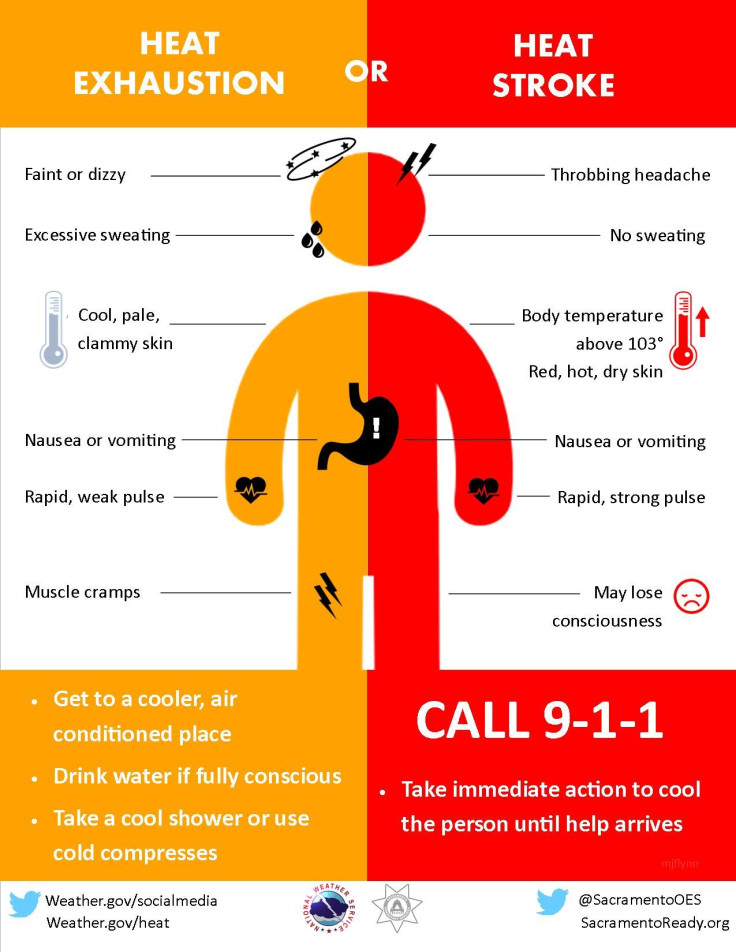Summer 2017: Heat Stroke, Heat Exhaustion, Heat Cramps — Learn Signs, What To Do

High temperatures promising to sweep the United States this summer mean more sunny days spent outside enjoying the weather, sometimes at the beach or by the pool. But the ill-effects of the heat can creep up on you, so make sure you know the warning signs and what to do if you or someone else falls ill due to the excessive heat.
The best thing you can do when it comes to braving the summer heat is to take precautions and be prepared adequately if you’re going to be outside for extended periods of time during the hottest part of the day.
Read: What Is A Rip Current? Here's How They Form And How To Survive One
One of the best ways to safeguard against unrelenting heat is to stay hydrated. The Red Cross advises drinking water even if you don’t feel thirsty to avoid succumbing to dehydration. Having small amounts of water throughout the day instead of having a lot in a short amount of time can help you accomplish this. Additionally, they advise avoiding drinks with caffeine or alcohol, in part because they may make you need to go to the bathroom more frequently. Your best bet is drinking water and having small snacks throughout the day.
In addition to staying hydrated, it’s important to spend as little time as possible outside during the hottest part of the day. If you do have to spend time outside, try to stay in the shade and wear loose-fitting, lightly colored clothing that won’t trap or absorb heat. See if you can go somewhere air conditioned if you don't have it at home. Libraries, schools, malls and movie theaters are good options.
Remember that young, old and sick people are more likely to suffer from heat-related illnesses. And keep in mind that pets also can suffer from the heat, so make sure they don’t spend too much time outside and have plenty of water and shade if they have to be outside. Always check the backseat before leaving the car and never leave a child, pet or elderly person in a car in the heat.
How to identify heat-related illnesses and what to do about them:
There are a few different heat related illnesses that all need to be addressed fairly quickly when someone falls ill.
Heat stroke is severe and needs to be treated by a medical professional. It’s more serious than heat exhaustion, so if you think someone is suffering from heat stroke, call 911. You can identify whether a person is suffering from heat stroke based on a few symptoms. Typically people suffering from heat stroke will have a throbbing headache accompanied by a lack of sweat despite the extreme heat, NOAA said. Victims also may exhibit an unusually high body temperature and red, hot or dry skin. People suffering from heat stroke may pass out, throw up or feel very nauseous and have a rapid strong pulse.
Heat exhaustion is a slightly milder version of heat stroke. People also may feel nauseous or throw up, and also may feel dizzy or lightheaded, sweat profusely and exhibit cool, pale and clammy skin. They also shouldn’t pass out but may have muscle cramps instead and a faint but rapid pulse. NOAA advised if someone is suffering from heat exhaustion, they move to a cooler, preferably air-conditioned area. They should also sip water if they’re fully awake and not groggy and cool compresses should be applied to the body, or they should take a cool shower.
Read: The Best Horror Movies Coming To Theaters In Summer 2017
Heat cramps may be experienced with heat exhaustion. They commonly occur in the legs or stomach area and are usually accompanied by extreme sweats. They should be treated by massaging the muscles and with sips of water unless the person is nauseous. Heat cramps occur when you begin doing activity in the heat and your body isn’t used to it yet. When you sweat a lot your body loses electrolytes that help keep it in balance and keep your muscles working properly, WebMD explained. Replenishing these electrolytes can be key to alleviating the cramps with a snack and some water or a carbohydrate sports drink can help, the Centers for Disease Control and Prevention said.
You can check the National Weather Service’s website for any weather-related warnings, including heat advisories and warnings in your area.

© Copyright IBTimes 2025. All rights reserved.



















